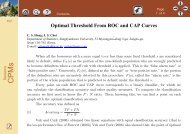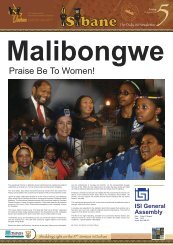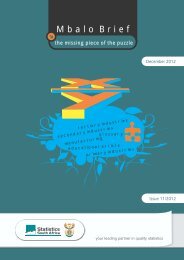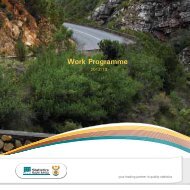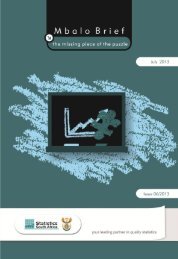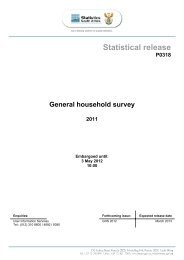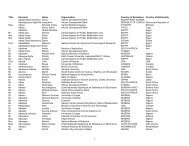Post-enumeration Survey (PES) - Statistics South Africa
Post-enumeration Survey (PES) - Statistics South Africa
Post-enumeration Survey (PES) - Statistics South Africa
Create successful ePaper yourself
Turn your PDF publications into a flip-book with our unique Google optimized e-Paper software.
<strong>Statistics</strong> <strong>South</strong> <strong>Africa</strong><br />
59<br />
Figure 16: Graphic representation of confidence intervals for household undercount rate, by<br />
province<br />
Lower and upper limits<br />
Among the provinces, the highest household undercount was observed in Western Cape, North West<br />
and KwaZulu-Natal (17,8%, 17,0% and 16,5% respectively) (see Table 19 and Figure 16). There is no<br />
significant undercount difference between Western Cape and North West. The lowest undercount was<br />
observed in Free State (9,4%), which closely followed by Limpopo which had an undercount of 9,6%.<br />
7.3 The adjustment<br />
The adjustment procedure for households was similar to the adjustment procedure for persons. It<br />
consisted of creating homogeneous adjustment classes with similar coverage rates – based on<br />
geography type, province, household size, and population group of head of household – and calculating<br />
a common population, undercount rate and adjustment factor, for each class separately. The national<br />
adjusted household total was obtained by summing across the adjustment classes. Only the households<br />
in the in-scope sub-universe received adjustment factors. The balance of the households (i.e., in noninstitutional<br />
collective living quarters other than hostels and in the out-of-scope EAs) were not adjusted<br />
(see Sections 5.5 and 5.6).<br />
<strong>Post</strong> Enumeration <strong>Survey</strong> (<strong>PES</strong>)



